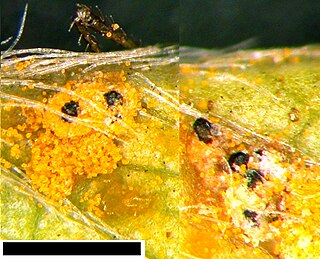Related Research Articles

Dothideomycetes is the largest and most diverse class of ascomycete fungi. It comprises 11 orders 90 families, 1,300 genera and over 19,000 known species. Wijayawardene et al. in 2020 added more orders to the class.

The Pleosporales is the largest order in the fungal class Dothideomycetes. By a 2008 estimate, it contained 23 families, 332 genera and more than 4700 species. The majority of species are saprobes on decaying plant material in fresh water, marine, or terrestrial environments, but several species are also associated with living plants as parasites, epiphytes or endophytes. The best studied species cause plant diseases on important agricultural crops e.g. Cochliobolus heterostrophus, causing southern corn leaf blight on maize, Phaeosphaeria nodorum causing glume blotch on wheat and Leptosphaeria maculans causing a stem canker on cabbage crops (Brassica). Some species of Pleosporales occur on animal dung, and a small number occur as lichens and rock-inhabiting fungi.

Dothideomycetidae is a subclass of Dothideomycetes consisting of three orders: Dothideales, Myriangiales and Capnodiales. The cavities of the sexual structures do not have vertical cells growing between the sac-like cells bearing the sexual spores (asci).

Pleosporomycetidae is a subclass of Dothideomycetes consisting of four orders: Pleosporales, Hysteriales, Mytilinidiales, and Jahnulales. One of its defining features is the presence of pseudoparaphyses. These are sterile cells extending down from the upper portion of the cavity inside sexual structures containing the sac-like asci with sexually produced spores (ascospores). Pseudoparaphyses are initially attached at both their ends, but sometimes the upper part may become free. Some orders and families where these cells are present remain outside the subclass since DNA based phylogenies cannot place them with confidence. However they could conceivably be included within Pleosporomycetidae in future.

Pleosporaceae is a family of sac fungi. They are pathogenic to humans or saprobic on woody and dead herbaceous stems or leaves.
The Melanommataceae are a family of fungi in the order Pleosporales. Taxa are widespread in temperate and subtropical regions, and are saprobic on wood and bark.
The Roussoellaceae are a family of fungi in the order Pleosporales. As accepted by Wijayawardene et al. 2020;

The Phaeosphaeriaceae are a family of fungi in the order Pleosporales. Species in the family have a cosmopolitan distribution, and are generally nectrotrophic or saprobic on a wide range of plants.
The Didymosphaeriaceae are a family of fungi in the order Pleosporales. The family was erected by Anders Munk in 1953.

The Massarinaceae are a family of fungi in the order Pleosporales. Although taxa have a cosmopolitan distribution, they are better-known in temperate regions. They are thought to be saprobic in wood and bark; some species are weak pathogens.

Lophiostoma is a genus of ascomycetous fungi in the family Lophiostomataceae.
Tremateia is a genus of fungi in the class Dothideomycetes. and in the family Didymosphaeriaceae and order Pleosporales.
Keissleriella is a genus of fungi, that was originally placed in the Massarinaceae family, before being placed in the Lentitheciaceae family.

Massarina is a genus of fungi in the Massarinaceae family. Anamorph forms of species in Massarina include Acrocalymma, Ceratophoma, and Tetraploa. Massarina was circumscribed by Pier Andrea Saccardo in 1883. The widespread genus contains about 100 species.
Lindgomyces is a genus of aquatic fungi in the family Lindgomycetaceae. Described as new to science in 2010, the genus contained six species known from Japan and the USA. More were added later, up to 14 species were accepted by Wijayawardene et al. 2020.

Dictyosporium is the type genus of fungi belonging to the family Dictyosporiaceae. By an estimate in 2018 it is formed by 45 species.
Lindgomycetaceae is a family of fungi in the order Pleosporales. Described as new to science in 2010, the family contains seven genera.
The Lentitheciaceae are a family of fungi in the order of Pleosporales. They are found world-wide with the greatest contributions found in Europe and Australia.
Etheirophoraceae is a family of ascomycetous marine based fungi within the order of Torpedosporales in the subclass Hypocreomycetidae and within the class Sordariomycetes. They are saprobic on intertidal wood and bark within marine habitats.

Neocamarosporium is a genus of ascomycete fungi, as accepted by Wijayawardene et al. 2020. The species are typically halotolerant, being commonly found in saline environments like in saline water, hypersaline soils and especially in association with halophytes.
References
- ↑ Cannon PF, Kirk PM (2007). Fungal Families of the World. Wallingford, UK: CAB International. ISBN 0-85199-827-5.
- ↑ Mugambi, GK; Huhndorf, SM (2009). "Molecular phylogenetics of Pleosporales: Melanommataceae and Lophiostomataceae re-circumscribed (Pleosporomycetidae, Dothideomycetes, Ascomycota)". Studies in Mycology. 64: 103–121. doi:10.3114/sim.2009.64.05. PMC 2816968 . PMID 20169025.
- ↑ Zhang, Y; et al. (2012). "Pleosporales". Fungal Divers. 53 (1): 1–221. doi:10.1007/s13225-011-0117-x. PMC 3477819 . PMID 23097638.
- ↑ Hyde, KD; et al. (2013). "Families of Dothideomycetes". Fungal Divers. 63: 1–313. doi:10.1007/s13225-013-0263-4.
- ↑ Wijayawardene, NN; et al. (2014). "Naming and outline of Dothideomycetes". Fungal Divers. 69 (1): 1–55. doi:10.1007/s13225-014-0309-2. PMC 4896388 . PMID 27284275.
- ↑ Schoch, CL; et al. (2006). "A multigene phylogeny of the Dothideomycetes using four nuclear loci". Mycologia. 98 (6): 1041–1052. doi:10.1080/15572536.2006.11832632. PMID 17486979.
- ↑ Schoch, CL; et al. (2009). "A class–wide phylogenetic assessment of Dothideomycetes". Stud Mycol. 64: 1–15. doi:10.3114/sim.2009.64.01. PMC 2816964 . PMID 20169021.
- 1 2 Thambugala, KM; et al. (2015). "Towards a natural classification and backbone tree for Lophiostomataceae, Floricolaceae, and Amorosiaceae fam. nov". Fungal Diversity. 74: 199–266. doi:10.1007/s13225-015-0348-3.
- ↑ Zhang, Y.; et al. (2009). "Towards a phylogenetic clarification of Lophiostoma / Massarina and morphologically similar genera in the Pleosporales". Fungal Diversity. 38: 225–251.
- ↑ Wijayawardene, Nalin; Hyde, Kevin; Al-Ani, Laith Khalil Tawfeeq; Somayeh, Dolatabadi; Stadler, Marc; Haelewaters, Danny; et al. (2020). "Outline of Fungi and fungus-like taxa". Mycosphere. 11: 1060–1456. doi: 10.5943/mycosphere/11/1/8 . hdl: 10481/61998 .